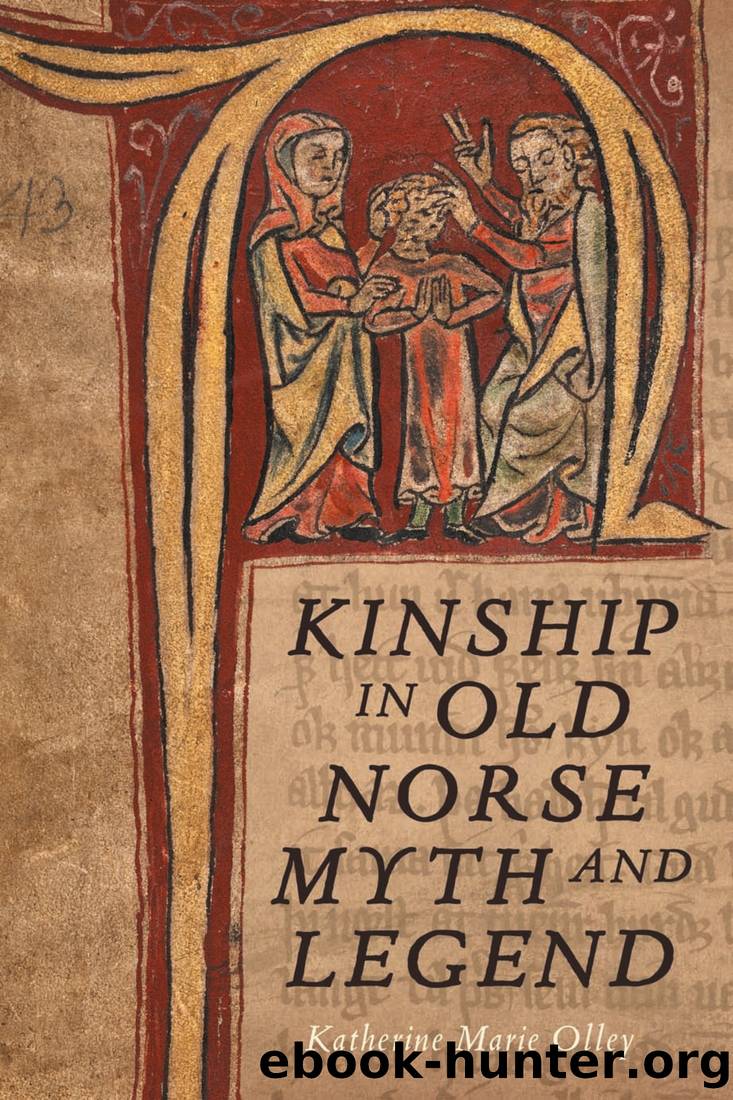Kinship in Old Norse Myth and Legend by Katherine Marie Olley;

Author:Katherine Marie Olley; [Olley;, Katherine Marie]
Language: eng
Format: epub
ISBN: 9781843846376
Publisher: Boydell & Brewer
Published: 2022-07-19T00:00:00+00:00
Mothers and Daughters: The Perverse Mother
Compared to mother-son relationships, depictions of mother-daughter interactions are uncommon in mythic-heroic texts. Like many of the mothers themselves, mother-daughter relations are often invisible, sometimes implied but infrequently depicted. Not only in mythic-heroic texts but in Old Norse literature more widely, âinformation about mothers and daughters â not to speak about a loving relationship â is extremely rareâ.96 There is evidence enough, however, to demonstrate that closeness between mother and daughter was not encouraged. Guðrúnâs excessive grief at the death of Svanhildr leads her to destroy what little is left of her family. Only bitterness results from Ãlöfâs continual confrontation with her own disgrace in the form of her daughter Yrsa in Hrólfs saga kraka. These cautionary exemplars contrast with the highly successful career of Ãslaug, who fared much better as a mother herself for being sent away by her own mother, Brynhildr, shortly after she was born. Ãslaugâs most positive parental figure as a child is her male foster-father, Heimir, since neither her birth-mother nor her foster-mother are depicted as particularly nurturing individuals.
Only two mother-daughter relationships provide enough material for close analysis, Ãlöf and Yrsa in Hrólfs saga kraka and GrÃmhildr and Guðrún, in both Völsunga saga and the Poetic Edda. Both are suggestive of a deep-rooted ambivalence at the heart of mother-daughter relationships, which both recalls that expressed between mothers and sons yet at the same time is distinct from it. It is the coincidence of gender which makes mother-daughter relations so singular, for, as with fathers and sons, mothers and daughters hold up a mirror to one another. Mothers, who were once daughters, raise daughters who will one day be mothers in their turn and so, like the father-son relationship, mother-daughter relations provide a space for self-reflection, wherein mother and daughter respond to the hints of their past or future which they identify in the experience of the other.
GrÃmhildr and Guðrún: Becoming the Mother
GrÃmhildr is introduced in Völsunga saga as in fjölkunnga (the one skilled in magic) and described as a grimmhuguð kona (grim-minded woman).97 She is quickly established as an influential queen, far busier on her dynastyâs behalf than her husband, King Gjúki. In the saga, it is GrÃmhildr who arranges the match between Guðrún and Sigurðr, not Gjúki. Indeed she goes so far as to persuade her husband to offer Sigurðr their daughter as a bride rather than wait for him to make the customary approach in case the opportunity should be lost.98 Ever eager to expand her influence, which is always anchored in her maternity, she tells Sigurðr she will be like a mother to him: âÃinn faðir skal vera Gjúki konungr, en ek móðirâ (Your father shall be King Gjúki, and I your mother).99 Similarly, Guðrún tells Brynhildr not to blame GrÃmhildr for their unhappy situation, âþvà at hún er til þÃn sem til dóttur sinnarâ (because she treats you like her own daughter), a comment that is darkly ironic in its truthfulness, for GrÃmhildrâs cruel treatment of Brynhildr is no more than she metes out to her own daughter by blood.
Download
This site does not store any files on its server. We only index and link to content provided by other sites. Please contact the content providers to delete copyright contents if any and email us, we'll remove relevant links or contents immediately.
The Power of Myth by Joseph Campbell & Bill Moyers(925)
Half Moon Bay by Jonathan Kellerman & Jesse Kellerman(911)
A Social History of the Media by Peter Burke & Peter Burke(880)
Inseparable by Emma Donoghue(844)
The Nets of Modernism: Henry James, Virginia Woolf, James Joyce, and Sigmund Freud by Maud Ellmann(739)
The Spike by Mark Humphries;(719)
A Theory of Narrative Drawing by Simon Grennan(706)
The Complete Correspondence 1928-1940 by Theodor W. Adorno & Walter Benjamin(703)
Ideology by Eagleton Terry;(659)
Bodies from the Library 3 by Tony Medawar(648)
Culture by Terry Eagleton(646)
World Philology by(645)
Farnsworth's Classical English Rhetoric by Ward Farnsworth(641)
A Reader’s Companion to J. D. Salinger’s The Catcher in the Rye by Peter Beidler(614)
Adam Smith by Jonathan Conlin(607)
High Albania by M. Edith Durham(592)
Game of Thrones and Philosophy by William Irwin(592)
Comic Genius: Portraits of Funny People by(581)
Monkey King by Wu Cheng'en(575)
